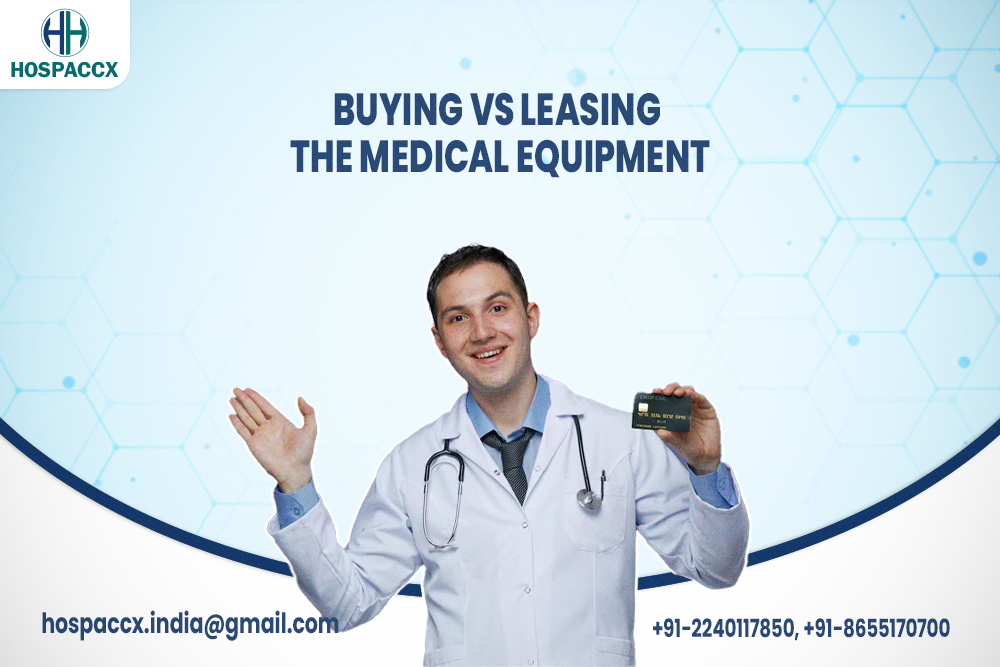BUYING VS LEASING THE MEDICAL EQUIPMENT
INTRODUCTION
Healthcare providers, whether it be a health system, a hospital, or a physician group, need medical equipment in order to provide medical care to their patients. Medicine is practiced in a wide spectrum of settings including ambulatory surgery centres, freestanding emergency departments, medical office buildings, and hospitals. Regardless of provider and location, the question of whether to lease or own medical equipment is one of importance—and healthcare organizations should understand the pros and cons of medical equipment.
Considering the above facts, Hospaccx team is involved in the market trends and dynamic of buying or leasing of the medical equipment. This is macroficial study of buying vs. leasing the medical equipment if you want to get into more detail you can contact hospaccxconsulting.com
THE PROS AND CONS OF BUYING
As with any choice, there are pros and cons to buying and leasing medical equipment. Typically, the pros and cons of buying include the following:
PROS OF BUYING
– Lower Occupancy Cost: Today’s interest rates are still near historical lows. Owners usually enjoy a lower cost of occupancy than lessors.
– Offsetting Revenue: There is the potential for additional rental revenue from third-party tenants, which lowers overall cost to ownership.
– Control: Owners can control the tenant mix of their buildings. Additionally, owners control which spaces to occupy in their buildings and how long to stay in those spaces.
– Potential Tax Benefits: Some municipalities do not assess property taxes against not-for-profit healthcare entities who own the equipment, which ultimately lowers the cost of ownership. However, this is becoming less common for cash-strapped municipalities. Additionally, equipment depreciation expenses could potentially be used to lower for-profit health systems’ taxable income.
– Terminal Value and Potential for Appreciation: The biggest benefit to owning the equipment is that after it has been paid off, the health system retains a marketable asset from which it can continue to generate revenue or which it can use to reduce its operating expenses by not having to pay for space it needs to conduct its operations. Additionally, the property value of the asset may appreciate over time, providing owners with additional financial benefits.
CONS OF BUYING
– Higher Up-Front Costs: The up-front costs to own usually consist of an equity investment in the property and tenant improvement costs. However, in some cases, creditworthy physician groups and hospitals can receive 100% financing.
– Long-Term Commitment: Because of higher up-front costs, higher disposition costs, and risk in the sale price, ownership is a long-term commitment.
– Refinance Risk: Owners who have financed with a loan that does not fully amortize are subject to interest rate risk at time of refinance. Because interest rates are currently near historical lows and are set to increase in the future, refinancing will likely result in higher financing costs and translate to higher ownership costs for equipment.
– Disposition Risk: Owners face risk of the medical equipment markets when they buy or sell medical equipment. Today’s medical equipment market remains at historic high prices, which increases the risk that the property value may be less when it is sold.
– Management / Capital Expenses: When health systems own medical equipment, they have to manage and upkeep those assets, which most healthcare organizations are not in the business of doing. Proper management of medical equipment requires time, expertise and resources, including property managers, accounting professionals, maintenance staff, and legal counsel. All of this adds to the cost of owning medical equipment.
– Unexpected Expenses: Not all expenses are typically passed through to a tenant. The owner takes on the risk of major ownership expenses, such as structural deficiencies or major building system replacement.
THE PROS AND CONS OF LEASING
Typically, the pros and cons of leasing include the following:
PROS OF LEASING
– Flexibility: The tenant’s commitment to a location is more flexible. This can be prudent if expanding into a new location.
– Less Up-Front Capital: Traditionally, leasing has required less up-front capital. As stated above, however, this benefit has been muted due to recent aggressive lending practices for medical equipment, which allow some creditworthy owners to obtain 100% financing at historically low interest rates. Additionally, tenants may be required to fund tenant improvement costs, which, in some cases, could be high and, thus, minimize this benefit.
– Ease of Disposition: There are less costs associated with disposition. The tenant can simply end the lease and move out at the end of the lease term.
CONS OF LEASING
– Lack of Control: A landlord could refuse to renew the tenant’s lease or could lease a nearby space to tenant’s business competitors.
– Higher Occupancy Cost: Tenants typically have a higher on-going cost of occupancy than owners. At the end of the lease, tenants can face higher rental rates and less lucrative concession packages.
– Inability to Dispose Early: If the tenant desires to move prior to the end of the lease term, there could be costly penalties or even worse, the inability to terminate the lease.
– Lack of Terminal Value: Tenants do not own an asset with value at the end of the lease. As a result, the value of tenant’s lease payments and tenant improvement investments cannot be recaptured once the lease ends.
CONCLUSION
The choice to lease or buy equipment is going to depend ultimately on what one can afford and how fast the technology will go out of date. Some can easily afford to buy the equipment, if buying would be a financial hit but have good credit, it may be smarter to lease. With this information in hand, one can make the most educated choice about leasing or buying.
Are you planning to buy or lease a medical equipment for your healthcare organisation? We can help you to buy or lease medical equipment for your healthcare organisation, below are the equipment planning services that we offer:-
- Medical Equipment Planning
- Medical Equipment Budgeting with Need Assessment
- Planning of Pre-installation Services
- Delivery Coordination
- Equipment Installation Supervision
- Inventory Audit
- Infrastructure Adequacy Check
- Integration of Medical equipment with IT/PACS
- Procurement Management
It is the superficial and macro level study for more details kindly contact Hospaccx Healthcare business consulting Pvt. ltd on hospaccx.india@gmail.com Or you can visit our website on hospaccxconsulting.com
Related Team Members










